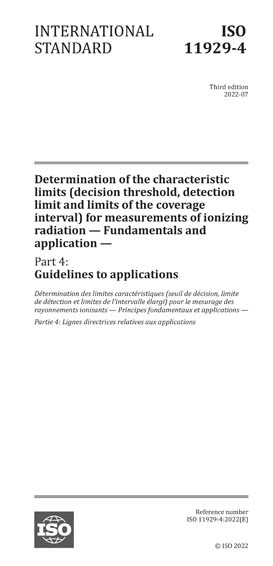Most recent
ISO 11929-4:2022
Determination of the characteristic limits (decision threshold, detection limit and limits of the coverage interval) for measurements of ionizing radiation - Fundamentals and application - Part 4: Guidelines to applications
This document specifies a procedure, in the field of ionizing radiation metrology, for the calculation of the “decision threshold”, the “detection limit” and the “limits of the coverage interval” for a non negative ionizing radiation measurand when counting measurements with preselection of time or counts are carried out. The measurand results from a gross count rate and a background count rate as well as from further quantities on the basis of a model of the evaluation. In particular, the measurand can be the net count rate as the difference of the gross count rate and the background count rate, or the net activity of a sample. It can also be influenced by calibration of the measuring system, by sample treatment and by other factors.
ISO 11929 has been divided into four parts covering elementary applications in ISO 11929-1, advanced applications on the basis of the ISO/IEC Guide 98-3:2008/Suppl.1 in ISO 11929-2, applications to unfolding methods in ISO 11929-3, and guidance to the application in ISO 11929-4.
ISO 11929-1 covers basic applications of counting measurements frequently used in the field of ionizing radiation metrology. It is restricted to applications for which the uncertainties can be evaluated on the basis of the ISO/IEC Guide 98-3 (JCGM 2008). In ISO 11929-1:2019, Annex A the special case of repeated counting measurements with random influences and in ISO 11929-1:2019, Annex B, measurements with linear analogous ratemeters are covered.
ISO 11929-2 extends ISO 11929-1 to the evaluation of measurement uncertainties according to the ISO/IEC Guide 98-3:2008/Suppl.1. ISO 11929-2 also presents some explanatory notes regarding general aspects of counting measurements and Bayesian statistics in measurements.
ISO 11929-3 deals with the evaluation of measurements using unfolding methods and counting spectrometric multi-channel measurements if evaluated by unfolding methods, in particular, alpha- and gamma-spectrometric measurements. Further, it provides some advice how to deal with correlations and covariances.
ISO 11929-4 gives guidance to the application of ISO 11929 (all parts), summarizing shortly the general procedure and then presenting a wide range of numerical examples. The examples cover elementary applications according to ISO 11929-1 and ISO 11929-2.
The ISO 11929 (all parts) also applies analogously to other measurements of any kind if a similar model of the evaluation is involved. Further practical examples can be found in other International Standards, for example, see References [1 to 20].
NOTE A code system, named UncertRadio, is available allowing for calculations according to ISO 11929-1 to ISO 11929-3. UncertRadio[40][41] can be downloaded for free from https://www.thuenen.de/en/fi/fields-of-activity/marine-environment/coordination-centre-of-radioactivity/uncertradio/. The download contains a setup installation file that copies all files and folders into a folder specified by the user. After installation one has to add information to the PATH of Windows as indicated by a pop up window during installation. English language can be chosen and extensive “help” information is available. Another tool is the package ‘metRology’[44] which is available for programming in R. It contains the two R functions ‘uncert’ and ‘uncertMC’ which perform the GUM-conform uncertainty propagation, either analytically or by the Monte Carlo method, respectively. Covariances/correlations of input quantities are included. Applying these two functions within iterations for decision threshold and the detection limit calculations simplifies the programming effort significantly. It is also possible to implement this document in a spreadsheet containing a Monte Carlo add-in or into other commercial mathematics software.
Content Provider
International Organization for Standardization [iso]






